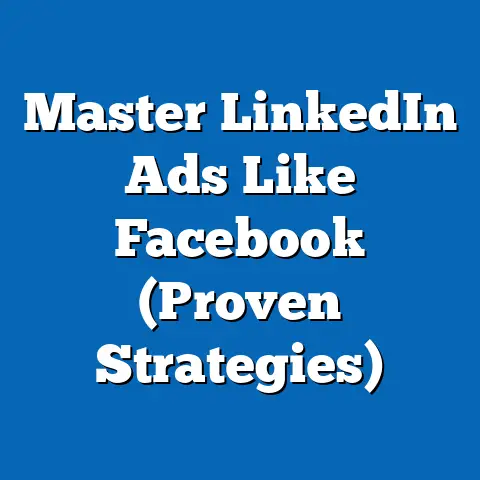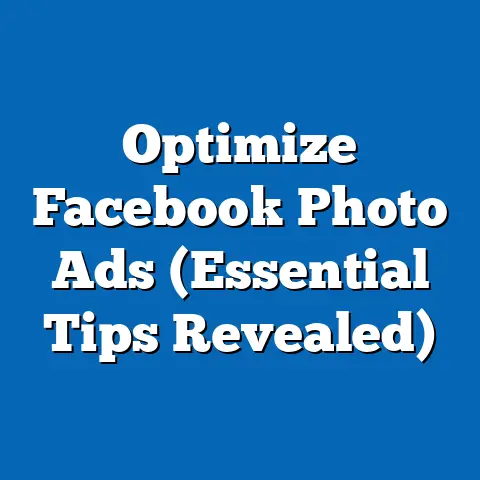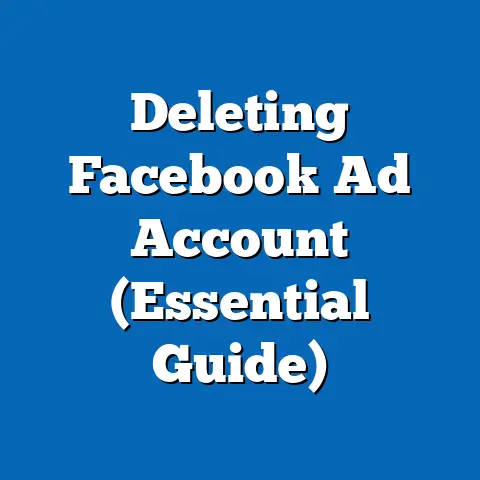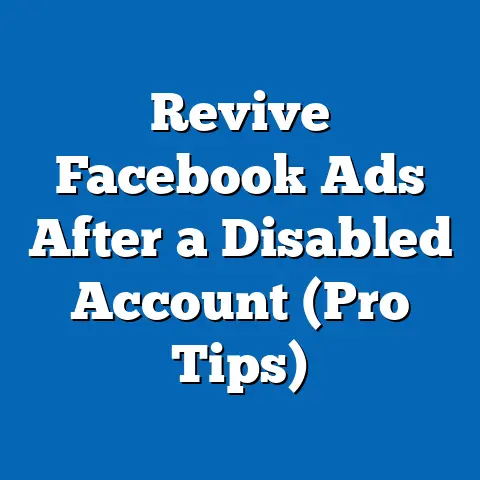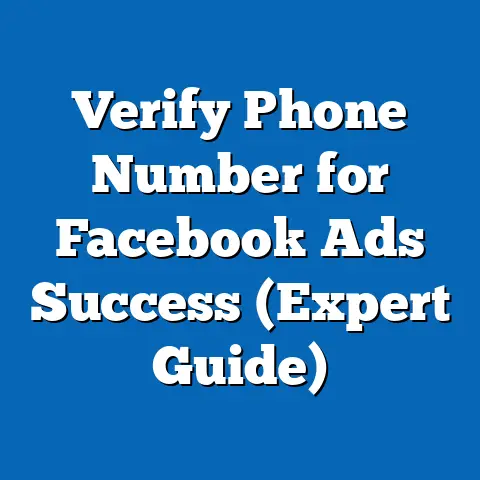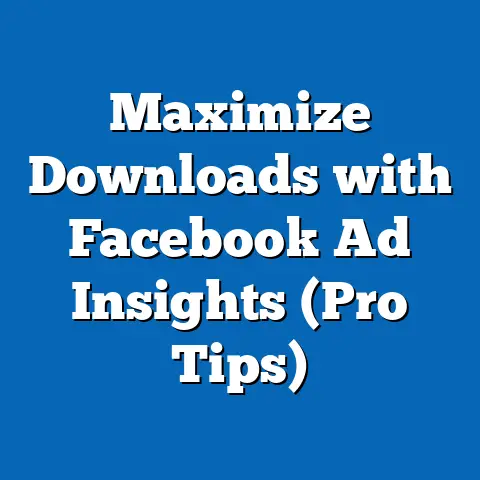Maximize Pharmacy Reach with Facebook Ads (Proven Strategies)
Did you know that 73% of marketers believe that their efforts through social media marketing, including Facebook ads, have been ‘somewhat effective’ or ‘very effective’ in reaching their target audience? That’s a staggering statistic, and it underscores the immense potential Facebook holds for businesses of all kinds, including pharmacies.
I’ve seen firsthand how a well-crafted Facebook Ads strategy can transform a local pharmacy from a neighborhood staple to a recognized and trusted healthcare provider within its community. In this guide, I’m going to walk you through everything you need to know to harness the power of Facebook Ads and maximize your pharmacy’s reach. Let’s dive in!
Section 1: The Importance of Facebook Ads for Pharmacies
In today’s digital world, your online presence is just as crucial as your physical storefront. Think about it: where do you go when you need information? Probably Google or social media, right? Your customers are doing the same. Facebook, with its billions of active users, offers a unique opportunity to connect with your target audience in a personalized and engaging way.
Why Facebook Ads Matter
- Reach a Broad Audience: Facebook’s massive user base allows you to reach potential customers you might not otherwise connect with.
- Targeted Marketing: Facebook’s granular targeting options are unmatched. You can target users based on demographics, interests, behaviors, location, and even their health-related activities.
- Cost-Effective: Compared to traditional advertising methods like print or television, Facebook Ads can be significantly more budget-friendly, especially when you optimize your campaigns effectively.
- Build Brand Awareness: Consistent, engaging ads can help build brand recognition and establish your pharmacy as a trusted resource.
- Drive Foot Traffic: Promote special offers, events (like flu shot clinics), and new services to encourage local customers to visit your pharmacy.
- Boost Online Sales: If you have an online store, Facebook Ads can drive traffic and increase sales of over-the-counter medications and health products.
My Experience: A Local Pharmacy Success Story
I once worked with a small, family-owned pharmacy that was struggling to compete with larger chain stores. They were hesitant to invest in Facebook Ads, but after a few conversations and a carefully planned strategy, they decided to give it a try. We started with a modest budget and focused on targeting local residents with ads promoting their personalized customer service and convenient prescription refills. Within a few months, they saw a significant increase in new customers and a boost in overall revenue. They even started using Facebook Ads to announce special health events, which further solidified their position as a valuable resource in the community.
Key Takeaway: Facebook Ads offer pharmacies a powerful way to reach a broad audience, build brand awareness, and drive both online and offline sales.
Section 2: Understanding Your Target Audience
Before you start creating ads, you need to deeply understand who you’re trying to reach. Who are your ideal customers? What are their needs, concerns, and preferences?
Defining Your Pharmacy’s Customer Demographics
Think about your existing customer base. Consider these factors:
- Age: Are you primarily serving seniors, young families, or a mix of age groups?
- Location: Focus on the geographical area surrounding your pharmacy.
- Interests: What are their hobbies, interests, and lifestyle choices?
- Health Concerns: What health conditions are prevalent in your community?
- Income Level: This can influence their purchasing power and preferences.
Creating Customer Personas
A customer persona is a semi-fictional representation of your ideal customer, based on research and data about your existing and potential customers. Give your persona a name, a job, a family situation, and specific needs.
Example:
- Name: Maria Rodriguez
- Age: 65
- Location: Lives within a 5-mile radius of the pharmacy
- Occupation: Retired teacher
- Health Concerns: Manages diabetes and high blood pressure
- Needs: Reliable prescription refills, friendly and knowledgeable advice, convenient delivery options.
- Facebook Interests: Gardening, cooking, local community events.
Using Facebook Insights and Analytics Tools
Facebook provides powerful tools to help you understand your audience.
- Facebook Page Insights: This feature provides data about your page’s performance, including audience demographics, engagement rates, and reach. Pay attention to which posts resonate most with your audience.
- Facebook Audience Insights: This tool offers even more detailed information about your potential audience, including their interests, behaviors, demographics, and purchasing habits. This helps you refine your targeting strategy.
- Google Analytics: If you have a website linked to your Facebook page, Google Analytics can provide valuable insights into website traffic and user behavior.
Key Takeaway: Understanding your target audience is crucial for creating relevant and effective Facebook Ads. Use Facebook Insights and other analytics tools to gather data and create detailed customer personas.
Section 3: Creating Compelling Ad Content
The quality of your ad content is critical to its success. You need to grab attention, convey your message clearly, and motivate users to take action.
Types of Facebook Ads and Their Effectiveness
- Image Ads: Simple, visually appealing ads that showcase a product or service. Use high-quality images that are relevant to your target audience.
- Video Ads: Engaging and informative, video ads can tell a story, demonstrate a product, or provide valuable health tips.
- Carousel Ads: Showcase multiple products or services in a single ad. This is great for highlighting a range of offerings or telling a story.
- Slideshow Ads: Similar to video ads, but use a series of still images. These are easier and less expensive to create than video ads.
- Collection Ads: Designed for mobile shoppers, collection ads allow users to browse and purchase products directly from the ad.
- Lead Generation Ads: Collect leads directly from Facebook by offering a valuable incentive, such as a discount or a free consultation.
Crafting Compelling Ad Copy
Your ad copy should be clear, concise, and persuasive.
Section 4: Targeting Strategies for Maximum Reach
Facebook’s targeting capabilities are what truly set it apart from other advertising platforms. You can precisely target your ideal customers based on a variety of factors.
Targeting Options Available on Facebook
- Location: Target people who live in a specific geographic area around your pharmacy.
- Demographics: Target people based on age, gender, education, income, and other demographic factors.
- Interests: Target people based on their interests, hobbies, and activities on Facebook.
- Behaviors: Target people based on their purchasing habits, online behavior, and device usage.
- Connections: Target people who are connected to your Facebook page or events.
Creating Custom Audiences
Custom audiences allow you to target specific groups of people based on your own data.
- Customer List: Upload a list of your existing customers (email addresses, phone numbers) to create a custom audience. This is great for retargeting existing customers with special offers or reminders.
- Website Traffic: Create a custom audience of people who have visited your website. This allows you to retarget them with relevant ads based on the pages they viewed.
- App Activity: If you have a mobile app, you can create a custom audience of people who have used your app.
- Engagement: Create a custom audience of people who have engaged with your Facebook page (liked a post, watched a video, etc.).
Creating Lookalike Audiences
Lookalike audiences allow you to reach new potential customers who are similar to your existing customers. Facebook analyzes your custom audiences and finds other users who share similar characteristics.
Retargeting Strategies
Retargeting involves showing ads to people who have previously interacted with your pharmacy (e.g., visited your website, engaged with your Facebook page, or made a purchase).
- Website Retargeting: Show ads to people who visited specific pages on your website.
- Engagement Retargeting: Show ads to people who liked your Facebook page, watched your videos, or attended your events.
- Abandoned Cart Retargeting: If you have an online store, show ads to people who added items to their cart but didn’t complete the purchase.
Key Takeaway: Effective targeting is crucial for reaching the right audience and maximizing the impact of your Facebook Ads. Use a combination of demographic, interest-based, custom, and lookalike audiences to reach your ideal customers.
Section 5: Budgeting and Bidding for Success
Setting a budget and choosing the right bidding strategy are essential for controlling your ad spend and achieving your marketing goals.
Setting a Budget for Facebook Ad Campaigns
- Start Small: If you’re new to Facebook Ads, start with a smaller budget and gradually increase it as you see results.
- Consider Your Goals: Your budget should align with your marketing goals. If you’re trying to build brand awareness, a lower budget might be sufficient. If you’re trying to drive sales, you might need a larger budget.
- Set a Daily or Lifetime Budget: You can set a daily budget (the average amount you’ll spend each day) or a lifetime budget (the total amount you’ll spend over the entire campaign).
- Monitor Your Spending: Regularly monitor your ad spend to ensure you’re staying within your budget.
Understanding CPC and CPM
- Cost-Per-Click (CPC): The amount you pay each time someone clicks on your ad.
- Cost-Per-Impression (CPM): The amount you pay for every 1,000 times your ad is shown.
Bidding Strategies
- Automatic Bidding: Facebook automatically sets your bids to get the most results for your budget. This is a good option for beginners.
- Manual Bidding: You set your own bids, giving you more control over your ad spend. This is a good option for experienced advertisers who understand how to optimize their bids.
Budget Allocation Examples
- Brand Awareness Campaign: Allocate a smaller budget to reach a broad audience and increase brand recognition.
- Engagement Campaign: Allocate a moderate budget to encourage likes, shares, and comments on your Facebook page.
- Conversion Campaign: Allocate a larger budget to drive sales or generate leads.
Key Takeaway: Setting a budget and choosing the right bidding strategy are essential for controlling your ad spend and achieving your marketing goals. Start small, consider your goals, and monitor your spending regularly.
Section 6: Analyzing and Optimizing Ad Performance
Analyzing your ad performance is crucial for understanding what’s working and what’s not. This allows you to optimize your campaigns and improve your results.
Key Performance Indicators (KPIs)
- Click-Through Rate (CTR): The percentage of people who see your ad and click on it. A higher CTR indicates that your ad is relevant and engaging.
- Conversion Rate: The percentage of people who click on your ad and complete a desired action (e.g., make a purchase, fill out a form, schedule an appointment).
- Cost Per Acquisition (CPA): The cost of acquiring a new customer or lead.
- Return on Ad Spend (ROAS): The amount of revenue you generate for every dollar you spend on advertising.
Analyzing Ad Performance Using Facebook Ads Manager
Facebook Ads Manager provides detailed data about your ad performance.
- Overview Tab: Provides a summary of your campaign performance, including reach, impressions, clicks, and conversions.
- Ad Sets Tab: Allows you to analyze the performance of individual ad sets (groups of ads targeting a specific audience).
- Ads Tab: Allows you to analyze the performance of individual ads.
A/B Testing
A/B testing involves creating two versions of an ad (A and B) and testing them against each other to see which one performs better.
- Test Different Ad Copy: Try different headlines, descriptions, and calls to action.
- Test Different Images: Use different images or videos to see which ones resonate best with your audience.
- Test Different Targeting Options: Experiment with different targeting options to see which audiences are most responsive.
Key Takeaway: Analyzing your ad performance and A/B testing different ad elements are crucial for optimizing your campaigns and improving your results. Track your KPIs, use Facebook Ads Manager to analyze your data, and continually experiment to find what works best.
Section 7: Leveraging User-Generated Content and Reviews
User-generated content (UGC) and customer reviews can be incredibly powerful tools for building trust and credibility.
The Power of User-Generated Content (UGC)
UGC is any content (text, images, videos) created by your customers and shared online.
- Authenticity: UGC is seen as more authentic and trustworthy than traditional advertising.
- Social Proof: UGC provides social proof that your pharmacy is reputable and provides good service.
- Engagement: UGC can generate more engagement and interaction than traditional advertising.
Encouraging Happy Customers to Share Their Experiences
- Ask for Reviews: Encourage satisfied customers to leave reviews on your Facebook page or other review sites.
- Run Contests: Host contests or giveaways that encourage customers to share their experiences.
- Feature UGC on Your Page: Share customer photos, videos, and testimonials on your Facebook page.
Integrating UGC into Facebook Ads
- Use Customer Testimonials: Feature customer testimonials in your ad copy.
- Showcase Customer Photos: Use customer photos in your ad images.
- Create Video Ads with Customer Stories: Create video ads that feature customer stories and testimonials.
Responding to Reviews and Engaging with Customers
- Respond to All Reviews: Respond to both positive and negative reviews in a timely and professional manner.
- Address Concerns: If a customer has a negative experience, address their concerns and offer a solution.
- Thank Customers: Thank customers for leaving positive reviews.
- Engage in Conversations: Respond to comments and questions on your Facebook page.
Key Takeaway: User-generated content and customer reviews can be incredibly powerful tools for building trust and credibility. Encourage happy customers to share their experiences, integrate UGC into your Facebook Ads, and respond to reviews and engage with customers.
Section 8: Staying Compliant with Regulations
Pharmacies must adhere to strict regulations when advertising on Facebook.
Regulatory Considerations
- HIPAA: Protect patient privacy by avoiding the use of protected health information (PHI) in your ads.
- FDA Guidelines: Follow FDA guidelines for advertising prescription drugs and medical devices.
- Facebook Advertising Policies: Adhere to Facebook’s advertising policies, which prohibit false or misleading claims.
Adhering to Privacy Laws and Advertising Guidelines
- Avoid Targeting Based on Health Conditions: Do not target people based on specific health conditions, as this could violate privacy laws.
- Be Transparent About Your Products and Services: Clearly disclose the benefits and risks of your products and services.
- Do Not Make False or Misleading Claims: Ensure that your ads are accurate and truthful.
- Include Disclaimers: Include disclaimers as required by law.
Resources for Ensuring Compliance
- FDA Website: Provides information about FDA regulations for advertising prescription drugs and medical devices.
- HIPAA Website: Provides information about HIPAA privacy laws.
- Facebook Advertising Policies: Outlines Facebook’s advertising policies.
Key Takeaway: Pharmacies must adhere to strict regulations when advertising on Facebook. Protect patient privacy, follow FDA guidelines, and adhere to Facebook’s advertising policies.
Conclusion:
We’ve covered a lot in this guide, from understanding the importance of Facebook Ads for pharmacies to creating compelling content, targeting the right audience, setting a budget, analyzing performance, leveraging user-generated content, and staying compliant with regulations. The potential for Facebook Ads to transform your pharmacy’s marketing efforts is immense. Remember, the digital landscape is constantly evolving, so it’s important to stay informed and adapt your strategies accordingly. Embrace these strategies, continually test and optimize your campaigns, and you’ll be well on your way to maximizing your pharmacy’s reach and connecting with your community in a meaningful way. Good luck!

